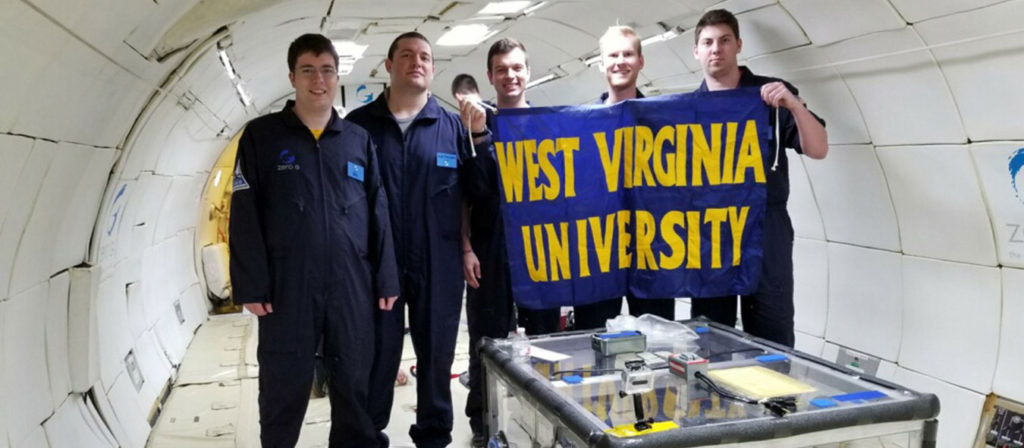A team of engineering students from West Virginia University recently conducted soldering experiments aboard the Zero Gravity Corporation’s microgravity research aircraft, G-Force One.
The team built upon work done by past WVU Microgravity Research Teams in an effort to remove bubbles or voids that form in solder joints when soldering is performed under microgravity conditions. According to team advisor John Kuhlman, professor emeritus of mechanical and aerospace engineering, the voids make the solder joints weaker and less electrically conductive than they would be if they were created within Earth’s normal gravity.
“Initially students conceived of the idea of using micron-size iron particles dispersed in a solder paste to strengthen the solder joint, and to make the molten solder susceptible to manipulation by external magnetic fields,” Kuhlman said. “The current team has hypothesized that melting this magnetic solder paste to solder within a magnetic field will impose a body force on the molten solder. This in turn will force the trapped flux vapor bubbles in the melted solder to flow out of the solder rather than remaining through the solidification process and forming voids in the joint.
“The experimental flight was undertaken to confirm this hypothesis, which has not been tested by anyone else to date,” Kuhlman added.
In preparation for the project, the students spent the past three semesters developing their magnetic solder and designed and constructed their experimental apparatus. Preliminary testing and experiments were conducted in laboratory space at WVU.
Five students – Tim Bear (mechanical and aerospace engineering, WVU Honors College, Carlisle, Pennsylvania), Matt Eberspeaker (mechanical engineering, Salisbury, Maryland), Anthony Fucello (electrical and computer engineering, Morgantown), Ray Nevling (mechanical and aerospace engineering, Cocoa Beach, Florida) and Robert Wilson (mechanical and aerospace engineering, Wheeling) – conducted the research aboard G-Force One.
“The aircraft flew a total of 30 parabolic trajectories, such that the environment aboard the plane alternated between approximately 20 seconds of weightlessness followed by about a minute of hypergravity, or an increased level of gravitation that was above Earth’s normal gravity,” Kuhlman said.
“Since graduating from WVU and moving to Florida to work at NASA’s Kennedy Space Center, this experience was truly remarkable for me,” Nevling said. “It brought together the work I did as a student member of WVU MRT and the current work I do now for the space research industry. I couldn’t have asked for a better experience, team or professor.”
After completing their microgravity flight, the team toured the NASA Kennedy Space Center Visitor Center, and attended a social outing with six WVU engineering alumni who currently work at NASA KSC prior to returning to Morgantown. Work is currently underway to analyze all of the data that was obtained during the flight.
Additional team members include Frank “Mitch” Notarnicola (mechanical and aerospace engineering, Honors College, Chesapeake, Virginia), Maggie Krasny (mechanical and aerospace engineering, Honors College, Nokesville, Virginia) and William D. Moon IV (mechanical and aerospace engineering, Cumberland, Maryland). Aaron Dunkle, a graduate student in aerospace engineering from Huntington, served as graduate student mentor to the team.
Funding for the project came from a two-year NASA Undergraduate Student Instrumentation Project grant award and the WVU Department of Mechanical and Aerospace Engineering.
(From Mary Dillon for WVU Today. Photo courtesy of West Virginia University.)
